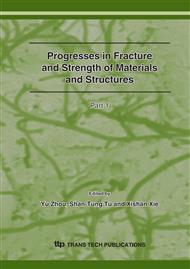p.603
p.607
p.611
p.615
p.619
p.627
p.631
p.635
p.639
Influence of Temperature and Heat-Aged Condition on the Deformation Behavior of Rubber Material Using SHPB Technique with a Pulse Shaper
Abstract:
The Split Hopkinson Pressure Bar (SHPB) technique with some special experimental apparatus can be used to obtain the dynamic material behavior under high strain rate loading conditions. An experimental technique that modifies the conventional SHPB has been developed for measuring the compressive stress strain responses of materials with low mechanical impedance and low compressive strengths such as rubber. This paper uses PEEK (Poly-ether-ether-ketone plastic) bars to achieve a closer impedance match between the pressure bar and the specimen materials. In addition, a pulse shaper is utilized to lengthen the rise time of the incident pulse to ensure stress equilibrium and homogeneous deformation of the rubber specimen. It is confirmed that the modified technique is useful to record the dynamic deformation behavior of rubbers under various conditions such as high strain rate with various temperature effect. Furthermore, the dynamic deformation behaviors of heat-aged rubber material under compressive high strain rate are evaluated using the modified SHPB technique.
Info:
Periodical:
Pages:
619-626
Citation:
Online since:
September 2007
Authors:
Price:
Сopyright:
© 2007 Trans Tech Publications Ltd. All Rights Reserved
Share:
Citation:


